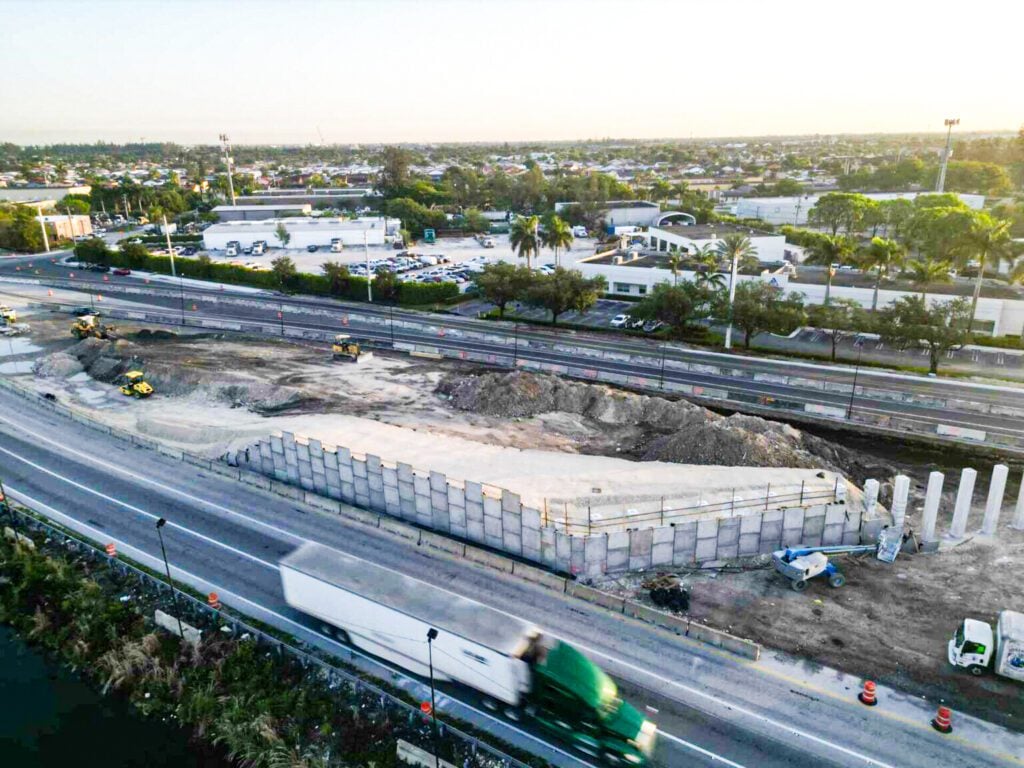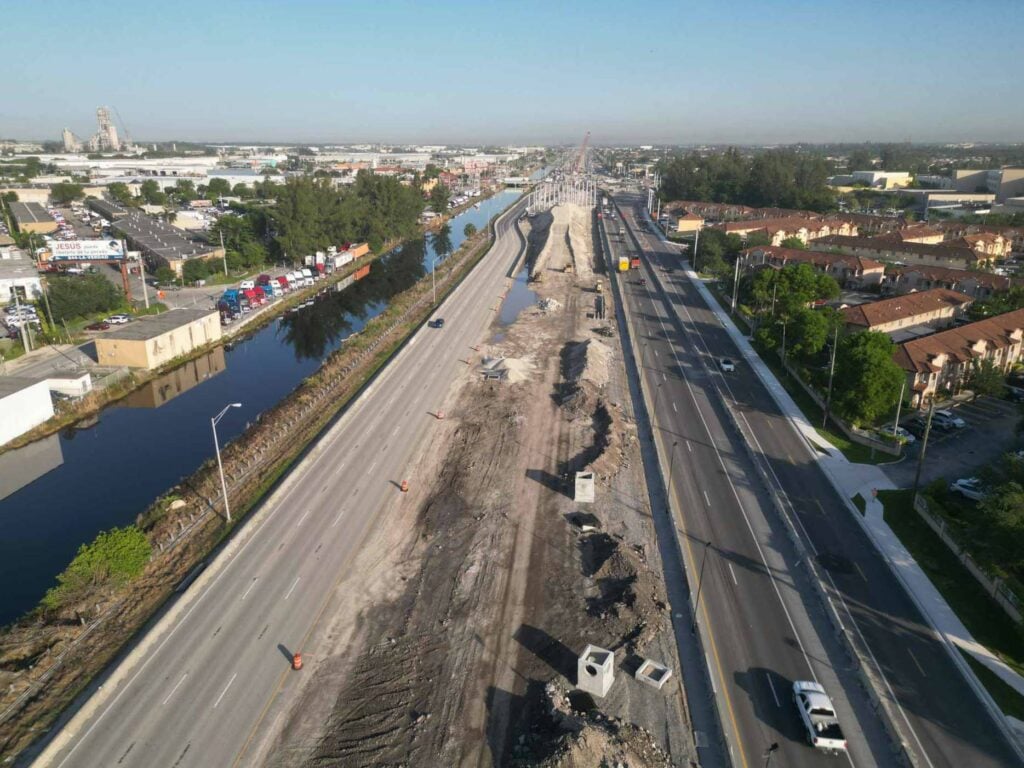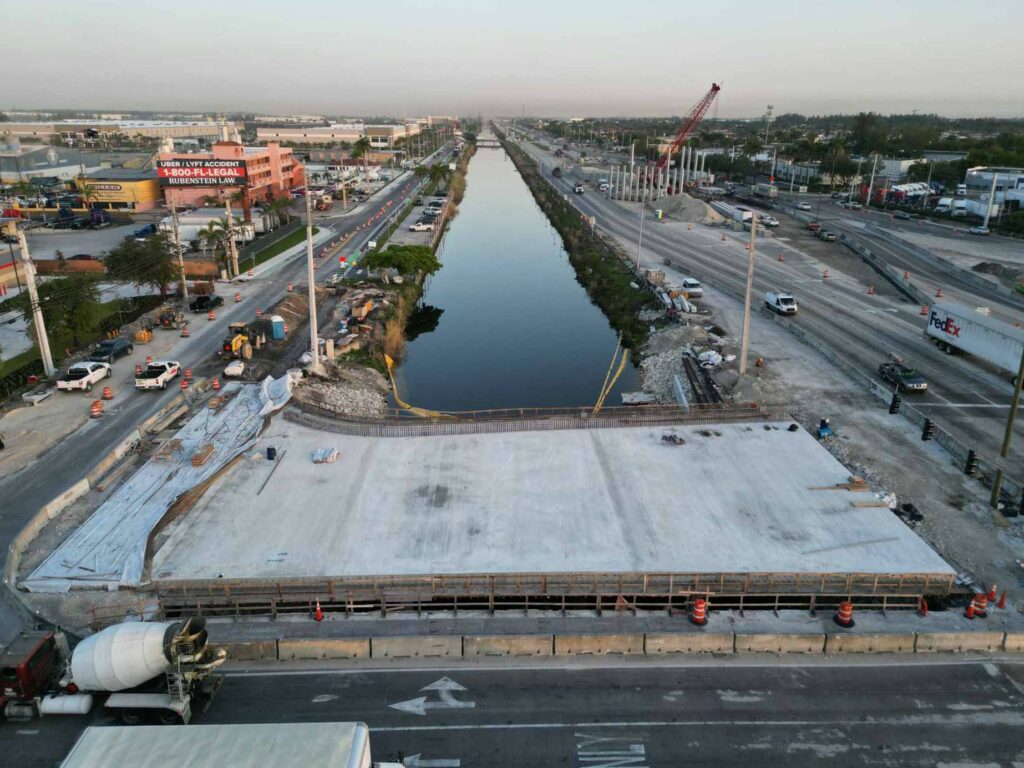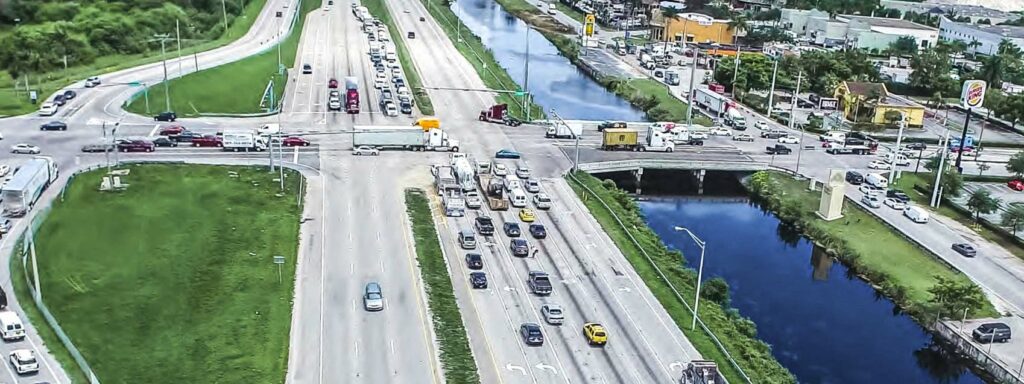With over 35,000 users every day, State Route (SR) 25 Okeechobee Rd. is a major arterial roadway in Miami-Dade County that is a crucial pathway for passengers traveling throughout South Florida.
It’s also a hurricane evacuation route and major freight transportation corridor, creating the perfect conditions for traffic jams and major back-ups.
To address this, a $105.6 million project improvement project is underway through the Florida Department of Transportation (FDOT) District 6 to reconstruct Okeechobee Rd. to cross Hialeah Gardens Blvd/NW 116th Way via a second-level overpass to improve safety and mobility and ease congestion.
Since May 2022, RK&K’s Construction Engineering & Inspection (CEI) team has headed the administration of this four-year contract.
This has included overseeing the construction of six new bridges and five new signalized intersections, concrete pavement construction, and the installation of 161 light poles, various ITS, utility, drainage, pedestrian, and bicycle facilities, and signing and pavement marking improvements.
Two bridges carrying traffic to and from SR 25 and NW 121st Way and NW 116th Way will be flat slab bridges supported by 24-inch concrete piles. At NW 121st Way, crews will reuse some of the foundation piles supporting the existing structure and add piles for the widening, but at NW 116th Way, the entire foundation will be new.
Speaking about the bridge work, Director of Construction Inspection/Field Enrique Tamayo, PE explained that a two-level, or echelon-style intersection was needed, in the area between Florida’s Turnpike to the Palmetto Expressway along SR 25, to handle traffic due to three closely spaced intersections and increased traffic volumes. This means the busier SR 25 will be elevated while the other direction, Hialeah Gardens Blvd/NW 116th Way, will remain at ground level. Ramps will provide access from one level to the other.
“What we’re going to do is elevate part of Okeechobee Rd. itself to a T-intersection. The drivers who wish to travel north-south along Okeechobee Rd. are going to be at an elevated grade, so they don’t mix with those that want to stay locally at the lower level,” said Tamayo.
This separation of traffic is expected to help reduce congestion by approximately 50% in the industrial and commercialized area which struggles with heavy truck traffic.
To service the area’s commercial truck traffic which constitutes around 15% of the total volume, the project is using concrete pavement, a stronger and longer-lasting solution than asphalt to handle heavier vehicles.
The reconstruction effort also included the installation of a 9 ½ foot drainage pipe under Okeechobee Rd. to canals on both sides, to best accommodate the needs of an environmentally sensitive area.
“We have the whole package on this type of project, so it’s very complex. It requires a lot of communication with the project’s many stakeholders,” said Project Engineer Felipe Gonzalez, PE.
Gonzalez adds that a lot of this communication has been focused on the maintenance of traffic as construction begins and causes lane closures. The team has been working with the project’s public information office to give the traveling public advance notice on upcoming traffic shifts and closures through press releases, outreach around local shopping centers and schools, radio, and newspaper ads, and even distributing flyers door to door.
The construction crews are working within protected work areas, keeping the same number of lanes open and minimizing lane closures to allowable non-peak hours.
“Not only are we engineers and construction managers, but also we have to be sensitive to the needs of the communities that we work in as well,” said Tamayo.
“The community sees the promise of this project and they know it’ll be an improvement to what they have previously been dealing with,” added Gonzalez.
Another unique aspect of this project is that the client is encouraging cost-saving initiatives that the contractor develops as they work, leading to a more dynamic design that can change daily.
Gonzalez said these are suggestions and modifications that will save FDOT and the contractor costs and potentially get the project completed quicker. While cost-saving, this also means the team has to adapt and work quickly with the new design.
Coordination between the project’s many stakeholders and other project teams is also critical since three sections are under construction at the same time.
“It’s a lot of moving parts and things to manage. Your mind is always thinking about the next step and what we can expect from this project. It has kept us all on our feet,” said Gonzalez.
“We are able to mesh together these many individual agendas to improve the overall success of the project,” Tamayo added.
The project is anticipated to be completed in early 2026 although Gonzalez said the contract includes up to a $4.7 million incentive to finish the project by as much as 100 days early, which the team is aiming for.
“As it often is on these major projects, progress is happening because the entire team is collaborating with each other,” said Gonzalez. “It’s not just me, it’s the combined work of various consultants, the inspection staff, the contractor, the FDOT, the public information office, and everyone else working towards the same goal.”
With over 35,000 users every day, State Route (SR) 25 Okeechobee Rd. is a major arterial roadway in Miami-Dade County that is a crucial pathway for passengers traveling throughout South Florida.





